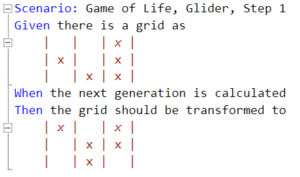
Dear BDD Addicts,
Our life has changed a lot since the last newsletter, so I could not even keep my pot boiling — hence the March-April merged issue. In this situation it’s a bit difficult to talk about BDD as if nothing would have happened around us. I have learned in the last few weeks that keeping the software industry going and helping people better collaborate with BDD are our responsibility.
This is how we can help saving jobs and support the economy in these hard times. So this is our monthly dose, starting with a scenario (based on the Wikipedia page about BDD) which is a tribute to John Conway, the man who invented The Game of Life. He has died recently as a victim of COVID19. R.I.P.

[BDD] Status of Specification by Example
It is not easy to recall how I learned about Specification by Example. I think I read Gojko Adzic’s book “Bridging the Communication Gap” somehow at the same time as I started developing SpecFlow. At the time when Gojko was preparing the “Specification by Example” book, I had already had some project experience with BDD and SpecFlow and I got invited to share my thoughts in the book. At that time the exact relationship of BDD and Specification by Example (SbE) was not that explicit and there was no consensus about it. It was clear however that the two concepts were going to the same direction. (Today I would say they are the same.) 10 years later, a survey was conducted by Gojko to assess how we stand with SbE (and BDD) today. The goal was not to measure how wide spread these methodologies are, but to see how SbE has changed and what the current focuses and challenges are. This is definitely an interesting read for all BDD practitioners.
Specification by Example, 10 years later (Gojko Adzic, @gojkoadzic)

[BDD] Learn & collaborate online
COVID19 has changed our life from one day to another. For me this meant that within a few days all of my upcoming onsite BDD courses got cancelled. Not a good perspective if you are a BDD trainer like me. But after reviving from the initial shock and having some discussions with fellow trainers I figured out a way how to practice even collaboration techniques like BDD at online/remote courses. And it worked. In this post I summarized my experience.
Things I have learned from my first online BDD course (Gaspar Nagy, @gasparnagy)

[BDD] BDD benefits
BDD works like a glue or umbrella in a way that it combines the power of different existing agile techniques. That’s why it is not easy to talk generally about the benefits of BDD. Although the practitioners generally agree on the advantages of a better collaboration, increased quality and shorter feedback cycles, the exact gains may vary from team to team. To discover the potential benefits, I generally recommend to have a look at them from the perspectives of the different roles. The next answer from Stack Exchange provides a good summary using this approach.
What are the pros & cons of BDD testing? (Stack Exchange community)

Source: BDD Vitals online course by Gaspar Nagy
[Test Automation] How to combine different test automation approaches?
Quite a few teams get stuck in the triangle of Unit, Integration and System (E2E) testing. We have already shared a few articles on this topic especially in relation to the test automation pyramid. Unfortunately there are not so many posts explaining what other options we have and what the benefits of these approaches are. The article by Luke Steensen provides a nice exception. He summarized what kinds of testing approaches they used for their product and why they did so.
How We Test Vector (Luke Steensen, GitHub:lukesteensen)

[Test Automation] Screenplay pattern for clearer BDD automation solutions
I am a big fan of using patterns in software development. Unfortunately for automation there are not so many of them available, so I am happy to hear about every new idea. Well, the Screenplay pattern is not particularly new, but definitely it has become widely known by now. Matt Wynne wrote a 3-part article series to explain how it works. (The bonus is that in the way along you can also learn about the driver pattern as well.)
Understanding Screenplay (part 2, part 3) (Matt Wynne, @mattwynne)


